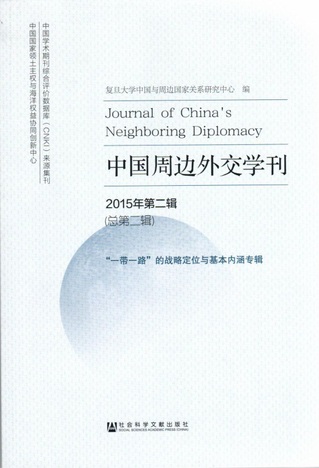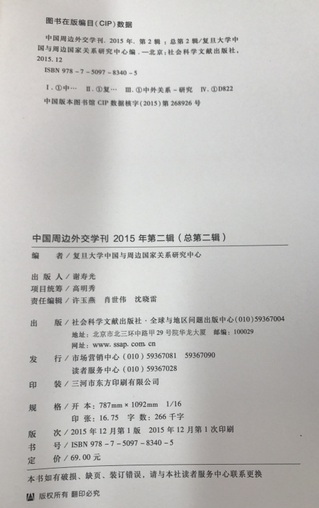Center for China’s Relations with Neighboring Countries of Fudan University (CCRNC-Fudan), ed., Journal of China’s Neighboring Diplomacy, Vol. 1, Issue 2, 2015.
Publisher: Social Sciences Academic Press (China)
Published in December 2015.
ISBN: 978-7-5097-8340-5
The Title Page of Journal of China’s Neighboring Diplomacy, Vol. 1, Issue 2, 2015 |
The Copyright Page of Journal of China’s Neighboring Diplomacy, Vol. 1, Issue 2, 2015 |
Contents
Preface SHI Yuanhua/1
“The Belt and Road” and China’s Grand Strategy
“The Belt and Road” in Line withthe Design of China’s Grand Strategy
WANG Hailiang/11
A Blueprint for “the Belt and Road”: Some Thoughts on Peace and Development
YU Xiangdong/26
“The Belt and Road” and China’s Neighboring Diplomacy
“The Belt and Road” and China’s External Cooperative Frameworks Covering All of Its Periphery
SHI Yuanhua/39
China’s “Four-Circle” Diplomacy towards Asia and the Strategic Framework of “the Belt and Road”
SU Hao/61
“The Belt and Road” and Its Implications for China’s Neighboring Diplomacy and Asian Economic Development
QI Huaigao/70
Opportunities and Challenges brought by the “the Belt and Road”
Building 21st-Century Maritime Silk Road: Challenges and Response
ZHAO Qinghai/89
The Connotation of “the Belt and Road” vs the Opportunity and Challenge in the Process of the Construction of the New Silk Road Economic Belt
ZHAO Weihua/100
The Contents, Risks, and Prospects of the “the Belt and Road” Strategy
BA Dianjun/115
“The Belt and Road”and Sub-Regional Cooperation
“The Belt and Road” and the Regional Cooperation in Northeast Asia
QIU Fahua/129
My perspective on the China-Pak & BCIM Corridors as the Pilot Projects for China's “the Belt and Road” Initiative
WANG Dehua/143
“The Belt and Road” and Shanghai
“The Belt and Road” Strategy and the Roles of Shanghai
WANG Haiyan/159
Neighboring Countries’ Perspectives on “the Belt and Road”
Japan's Interpretations and Responses to “the Belt and Road” Initiative: an Analytical Case Study on the Japanese Mainstream Media’s Coverage
ZHU Dandan/173
EU Policy Community’s Perceptions and Responses to China’s “the Belt and Road” Strategy
XIN Hua/190
A Review on the Positions and Attitudes of the Countries Relevant to the “the Belt and Road” Strategy
SHI Jianguo/206
Reviews on Symposiums
A Review on the Symposium of “the Strategic Positioning and Basic Contents of the ‘the Belt and Road’”
ZHANG Chi/229
A Review on the Symposium of “Transnational Ethnic Groups in the Perspective of Total Security View and the ‘the Belt and Road’”
MAO Yinghui TE Rile/240
Appendix
Introduction on the Collaborative Innovation Center for Territorial Sovereignty and Maritime Rights (CICTSMR) /249
Introduction on Center for China’s Relations with Neighboring Countries (CCRNC) /251
Notice Inviting Contributions to the Journal of China’s Neighboring Diplomacy /253
“The Belt and Road” in Line with the Design of China’s Grand Strategy
WANG Hailiang
Abstract:This paper argues that “the Belt and Road” is a great strategic conception,which wholly joints to and fits in China’s grand strategy. This lies in the fact that it is to play a very important role in the nation’s security strategy,development strategy and reunification strategy. As China is geo-strategically stranded on the sea in the Southern-east as well as in the East and relatively favored in the vast inland world in the West,“the Silk Road Economic Belt” is more vital than “the 21st-Century Maritime Silk Road” in the strategic construction,and therefore more valuable to the country’s strategic security. The construction of “the Belt and Road” can promote China’s all-round development. It can also maintain and advance the nation’s reunification so that it is significant to the reunification strategy.
Author:Wang Hailiang,curator of the library of Shanghai Academy of Social Sciences(SASS),secretary-general of the Center for Taiwan Studies at SASS,and presiding expert of the team of the digital document and information platform for SASS innovation project.
Official citation:Wang Hailiang, “‘The Belt and Road’ in Line withthe Design of China’s Grand Strategy”, Journal of China’s Neighboring Diplomacy, Vol. 1, Issue 2, 2015, pp. 11-25.
A Blueprint for “the Belt and Road”: Some Thoughts on Peace and Development
YU Xiangdong
Abstract:China’s blueprint for “the Silk Road Economic Belt” and “the 21st-Century Maritime Silk Road” is both an initiative and a strategy for China’s opening and external cooperation. Its step-by-step proceeding needs to be integrated into a process that should include these several major stages:initial external publicity to create foreign acceptance and interests,specific implementation in accordance with blueprint,further in-depth publicity and cooperation on more complex projects,and joint development of advantageous macro strategic pattern of the regions. In pace with the general trends of the world at present time towards peace,development,and win-win cooperation,“the Belt and Road” initiative reflects the visions and pursuits of the peoples in the countries and regions covered by this initiative,and indicates China’s firm willing to adopt the path of peaceful development and win-win cooperation. Within the complicated and fluid international patterns,only when the macro environment is beneficial to the world peace and development is protected,can it be possible to realize the blueprint of “the Belt and Road”. At the same time,“the Belt and Road” will also make a substantial contribution to the world peace.
Author:Yu Xiangdong,Professor,Ph.D. of History,Dean of the Institute of Marxist Studies and Director of the Institute for Vietnamese Studies at Zhengzhou University,Deputy Director of China’s Collaborative Innovation Center for Territorial Sovereignty and Maritime Rights(CICTSMR)and Head of its sub-center at Zhengzhou University.
Official citation:Yu Xiangdong, “A Blueprint for ‘the Belt and Road’: Some Thoughts on Peace and Development”, Journal of China’s Neighboring Diplomacy, Vol. 1, Issue 2, 2015, pp. 26-36.
“The Belt and Road” and China’s External Cooperative Frameworks Covering All of Its Periphery SHI Yuanhua
Abstract:“The Belt and Road” blueprint is China’s grand strategy that aims at making China adapted to its quick rise and responding to the U.S. strategy of “pivot to Asia”. This article explores the positioning of “the Belt and Road” strategy from the perspective of how to appropriately response to and defuse the U.S. strategy of “pivot to Asia”,and inquires “the Belt and Road” relations with China’s neighboring diplomacy,with a particular elaboration on the Northeast Asia as the weak link of China’s external cooperation frameworks covering all of its periphery. The author of this article proposes that it is possible and practical to make two breakthroughs to propel “the Belt and Road” strategy and effectively achieve a full coverage of China’s external cooperative frameworks over all of its neighborhood:1)The “China-North and South Korea-Russia Economic Corridor” should be initiated. 2)South Korea should be developed into a country of strategic pivot for propelling “the Belt and Road” strategy.
Author:Shi Yuanhua,Professor of the Institute of International Studies and Director of the Center for China’s Relations with Neighboring Countries at Fudan University,Deputy Director of the China’s Collaborative Innovation Center for Territorial Sovereignty and Maritime Rights(CICTSMR)and Head of its sub-center at Fudan University.
Official citation:Shi Yuanhua, “‘The Belt and Road’ and China’s External Cooperative Frameworks Covering All of Its Periphery”, Journal of China’s Neighboring Diplomacy, Vol. 1, Issue 2, 2015, pp. 39-60.
China’s “Four-Circle” Diplomacy towards Asia and the Strategic Framework of “the Belt and Road”
SU Hao
Abstract:In China’s blueprint,the “Four-Circle” multilateral regional cooperative framework is a complex of inherently integrated and interlocked links. This framework is structured by an east-west two-directional combination of the “East Asia Community” framework for East Asian regional cooperation and the “Shanghai Cooperation Organization” mechanism for Central Asian cooperation,which is supported by China’s harmonization with the “South Asian Association for Regional Cooperation(SAARC)” in the south and the China-Russia-Mongolia trilateral coordination group in the north. The above-mentioned major east-west structure is interlocked with the two frameworks in the south and north,forming a complete complex of four circles. In this way,China can get itself well integrated into the international community in the Asian region. Through its “Four-Circle” diplomacy,China will gradually push forward its “the Belt and Road” strategy,which may help China integrate the existing regional integration mechanisms of various levels and transform the Asia into a “uniformity of diversity”. Furthermore,it may be able to extend this integrated complex of Asia towards the European part of the Eurasia continent and finally construct a Eurasia community of destiny that connects different interests and creates a sharing of common rights and responsibilities among various countries all over the Eurasia continent. In this way,a “New Continental Age” of the international relations will emerge.
Author:Su Hao,Professor of the Department of Diplomacy and Director of the Center for Strategic and Management Studies at the China Foreign Affairs University,Academic Tutor for Ph.D. Candidates,Chinese Convener for the “South Korea-China Think Tank” forum.
Official citation: Su Hao, “China’s ‘Four-Circle’ Diplomacy towards Asia and the Strategic Framework of ‘the Belt and Road’”, Journal of China’s Neighboring Diplomacy, Vol. 1, Issue 2, 2015, pp. 61-69.
“The Belt and Road” and Its Implications for China’s Neighboring Diplomacy and Asian Economic Development
QI Huaigao
Abstract:“The Belt and Road” initiative has already created significant influences towards China’s neighboring diplomacy and Asia’s development since Chinese leaders first came up with this initiative in 2013. In the field of China’s neighboring diplomacy,the conception of “the Belt and Road” has instilled new vitality and vigor into the theories and practices of China’s diplomatic activities towards its neighboring countries,and is effectively integrating the two major ideas for China’s neighboring diplomacy:“active westward pioneering” and “breakthrough on the seas”. In this way,it contributes to China’s current effort to coordinate its neighboring diplomacy and China’s frontiers. In the field of Asian development,“the Belt and Road” can promote the interconnectivity between the different systems of infrastructures of Asian countries,facilitate the trade and investment between these countries,and particularly,propel the post-war reconstruction and economic development of underdeveloped Asian countries such as Afghanistan and Sri Lanka. Finally,it can create a platform for Asian countries along “the Belt and Road” to bring their comparative advantages into full play. In the meantime,“the Belt and Road” is also faced with five potential risks,so China should fully anticipate the future uncertainties and make good preparations to tackle them.
Author:Qi Huaigao,Associate Professor of Institute of International Studies and Deputy Director of the Center for China’s Relations with Neighboring Countries(CCRNC)at Fudan University. He is also an Adjunct Research Fellow at the Collaborative Innovation Center for Territorial Sovereignty and Maritime Rights(CICTSMR).
Official citation: Qi Huaigao, “‘The Belt and Road’and Its Implications for China’s Neighboring Diplomacy and Asian Economic Development”, Journal of China’s Neighboring Diplomacy, Vol. 1, Issue 2, 2015, pp. 70-86.
Building 21st-Century Maritime Silk Road: Challenges and Response
ZHAO Qinghai
Abstract:China faces a number of risks and challenges in the building of the 21st -Century Maritime Silk Road,such as strategic competitions with major powers like U.S.,Japan and India,investment hazard in the countries along the Road that might come with political turmoil and fragile economic structure,spillovers from the territorial disputes,regional conflict and non-traditional security threat. The above risks and challenges cannot be avoided,and they could even affect the policy alignment and coordination among these countries. However,it is hard to halt the progress of this initiative. China should cautiously respond to these risks and challenges,make an overall consideration on the whole implementation,properly handle the security issues,and build a comprehensive risk control mechanism.
Author:Zhao Qinghai,Professor,Director of Center for Maritime Security and Cooperation at the China Institutes of International Studies.
Official citation:Zhao Qinghai, “Building 21st-Century Maritime Silk Road: Challenges and Response”, Journal of China’s Neighboring Diplomacy, Vol. 1, Issue 2, 2015, pp. 70-86.
The Connotation of “the Belt and Road” vs the Opportunity and Challenge in the Process of the Construction of the New Silk Road Economic Belt
ZHAO Weihua
Abstract:Xi Jinping proposed the ideas of the “New Silk Road Economic Belt construction” and “21st Century Maritime Silk Road construction” when he visited Kazakhstan and Indonesia In autumn 2013,which means China will take the development road of both sea and land and also a conclusion on the long-standing geostrategic strategy debate. In 2014,Xi Jinping further announced that China will cooperate with surrounding countries through belt and road strategy and create the community of destiny and the community of interests with surrounding countries,which means that the initiative of belt and road officially become national strategy. As an important part of the strategy of belt and road,the new silk economic zone is in the interest of maintenance of the Geopolitical Security and energy security of China. However,the complex geopolitical situation in Central Asia also makes China face a series of challenges. China must seize the opportunity and face the challenge in the process of the construction of the new silk economic zone.
Author:Zhao Weihua,Ph.D candidate of the school of International Relations and Public Affairs,Fudan University,and Associate Professor of the Center for Vietnamses Studies,Honghe Prefecture,Yunnan Provence.
Official citation:Zhao Weihua, “The Connotation of ‘the Belt and Road’ vs the Opportunity and Challenge in the Process of the Construction of the New Silk Road Economic Belt”, Journal of China’s Neighboring Diplomacy, Vol. 1, Issue 2, 2015, pp. 100-114.
The Contents, Risks, and Prospects of the “the Belt and Road” Strategy
BA Dianjun
Abstract:Currently,the United States becomes more frequently involved into the regional affairs of China’s neighborhood and China’s interests become more globalized. Under such circumstances,“the Belt and Road” contains great significance because it may help to achieve the interconnectivities between the Eurasia Continent and the great oceans of the world through the tactic of open “economic alliance” and economic cooperation of a win-win pattern. “The Belt and Road” is a symbol indicating the emerging of Xi Jinping’s new diplomatic blueprint and prophesying a new reform on China’s regional and global strategies. From the perspective of geopolitics,China’s “the Belt and Road” aims at stabilizing and prospering China’s northwestern frontiers,establishing a community of destiny,promoting the “South-South Cooperation”,and constructing a “New Type of Great Power Relations”. However,it should be pointed out that major challenges and risks are confronting the strategy of “the Belt and Road” and its final success or failure will be determined by an interaction between geopolitical environments and real economic demands. It is not correct to overestimate the risks and stand still in hesitations,nor is it correct to unlimitedly exaggerate or overestimate the value and uses of this strategy.
Author:Ba Dianjun,Professor,Dean of the Institute of International Politics in the Institute for Northeast Asian Studies at the Jilin University.
Official citation:Ba Dianjun, “The Contents, Risks, and Prospects of the ‘the Belt and Road’ Strategy”, Journal of China’s Neighboring Diplomacy, Vol. 1, Issue 2, 2015, pp. 115-125.
“The Belt and Road” and the Regional Cooperation in Northeast Asia
QIU Fahua
Abstract:After “the Belt and Road” is proposed,its connotation has been enriched. For a long time,there has been a laggard in the regional economic cooperation in Northeast Asia,due to the confinement of the realistic geopolitical environment. Driven by “the Belt and Road” Initiative,it is both possible and practical to promote the construction of the sub-regional cooperation of the “Sino-Mongolia-Russia economic corridor”,the “Sino-North and South Korea economic circle” as well as the “Sino-Korea-Japan free trade area”. The integration of “the Belt and Road” Strategy with the existing frameworks of the Northeast Asia will not only contribute to the economic revival of China’s Northeast,but also promote the regional economic collaboration in Northeast Asia. “The Belt and Road” Initiative provides a new avenue for the regional cooperation in Northeast Asia.
Author:Qiu Fahua,Ph.D,Associate Professor of School of Social Science,University of Shanghai for Science and Technology.
Official citation:Qiu Fahua, “‘The Belt and Road’ and the Regional Cooperation in Northeast Asia”, Journal of China’s Neighboring Diplomacy, Vol. 1, Issue 2, 2015, pp. 129-142.
My Perspective on the China-Pak & BCIM Corridors as the Pilot Projects for China's “the Belt and Road” Initiative
WANG Dehua
Abstract:China-Pakistan & BCIM economic corridors will play a role of construction model for China’s “the Belt and Road” initiative. This paper will focus upon the following two aspects: (1)The strategic significance of “China-Pakistan & BCIM economic corridors” as pilot projects for the construction of China’s “the Belt and Road”; (2)challenges or impediments of the China-Pakistan & BCIM economic corridors and the problem of how to prevent the corridors from becoming failed projects?
Author: Wang Dehua,Professor and Dean of the Institute of South and Central Asia Studies at Shanghai Municipal Centre for International Studies,and Director of Center for South Asia Studies at Tongji University.
Official citation:Wang Dehua, “My perspective on the China-Pak & BCIM Corridors as the Pilot Projects for China's ‘the Belt and Road’ Initiative”, Journal of China’s Neighboring Diplomacy, Vol. 1, Issue 2, 2015, pp. 143-156.
“The Belt and Road” Strategy and the Roles of Shanghai
WANG Haiyan
Abstract: In the Euro-Asia region along “The Belt and Road”,Shanghai has geographical advantages,institutional innovation advantages,and advantages of talent aggregation and scientific and technological innovation. In the future,Shanghai can become the biggest city cluster,service center,and scientific and technological innovation center of “the Belt and Road” areas. In order to help Shanghai to cope with the challenges brought by the problems concerning regional security,resources,and adjustment of industrial structure,we propose the following measures:Shanghai should take an effort to build a regularized regional security system in collaboration with Chinese provinces and foreign countries along “the Belt and Road”,construct an inherent system that integrates various types of resources,and prioritize some specific categories and fields of its economy as key industries and sectors for Shanghai’s industrial development.
Author: Wang Haiyan,Associate Professor of the School of Advanced International and Area Studies at the East China Normal University.
Official citation:Wang Haiyan, “‘The Belt and Road’ Strategy and the Roles of Shanghai”, Journal of China’s Neighboring Diplomacy, Vol. 1, Issue 2, 2015, pp. 159-170.
Japan's Interpretations and Responses to “the Belt and Road” Initiative: an Analytical Case Study on the Japanese Mainstream Media’s Coverage
ZHU Dandan
Abstract:The Japanese mainstream media has been tracing and analyzing China’s “the Belt and Road” initiative since the second half of 2014. Their reports argued that this strategy is an embodiment of Chinese leadership’s intent to transform China into a superpower under the slogan of “the great rejuvenation of the Chinese nation” since Xi Jinping’s inauguration. They thought that China promotes this strategy partly for the purpose of checking or even counterbalancing the U.S. in the Asia-Pacific region. On one hand,the Abe Cabinet has been analyzing China’s external strategic intents from the perspective of how to convert Japan into a political and military power and thus establish a new identity and value that can be commonly accepted by the Japanese. On the other hand,ever since the founding of the Asia Infrastructure Investment Bank(AIIB)and the Silk Road Fund,the attitudes and stands of various Japanese social and interest groups have been gradually diverging from those of the Abe Administration on the problem of whether to cooperate with China in the field of Asian infrastructure investments. However,the public opinions can only pose a limited influence over the Japanese government. The Abe administration managed to manipulate the situations in the end,and came up with tit-for-tat policies towards China’s initiative of “The Belt and Road” initiative.
Author:Zhu Dandan,Associate Professor and Head of Section for Diplomacy Teaching of the Department of Diplomacy and Foreign Affairs Management at China Foreign Affairs University.
Official citation:Zhu Dandan, “Japan's Interpretations and Responses to ‘the Belt and Road’ Initiative: an Analytical Case Study on the Japanese Mainstream Media’s Coverage”, Journal of China’s Neighboring Diplomacy, Vol. 1, Issue 2, 2015, pp. 173-189.
EU Policy Community’s Perceptions and Responses to China’s “the Belt and Road” Strategy XIN Hua
Abstract: In China’s “the Road and Belt” initiative,Europe is located at the intersection of the “Silk Road Economic Belt” and the “Maritime Silk Road”,and it is also regarded as the westernmost end of this strategy’s whole route system. Therefore,the EU’s attitude contains great significance to this strategy. So far,three major types of players in EU’s policy community,namely,EU’s top leadership of policy making,European think tanks,and European business interest groups,have already responded to “the Belt and Road” initiative. The whole process of their cognition and assessment on it can be divided into three stages in accordance with the extent of their attentions and the frequency of their responses. EU’s top leadership has responded on four occasions,gradually clarifying their positive and affirmative attitude. European think tanks both on EU level and on its member state level have evaluated this strategy through systematic and detailed analyses from five layers of theoretic perspectives. European business interest groups also responded in a generally positive way. Finally,this paper envisages an overall plan to integrate China’s “the Belt and Road” initiative with EU’s five major frameworks of plans and initiatives for European regional development through specific paths and methods.
Author:Xin Hua, Ph.D., Associate Professor of the Center for EU Studies,Shanghai International Studies University,Councilor of the Shanghai Institute for European Studies.
Official citation:Xin Hua, “EU Policy Community’s Perceptions and Responses to China’s ‘the Belt and Road’ Strategy”, Journal of China’s Neighboring Diplomacy, Vol. 1, Issue 2, 2015, pp. 190-205.
A Review on the Positions and Attitudes of the Countries Relevant to the “the Belt and Road” Strategy SHI Jianguo
Abstract:China’s “the Belt and Road” Initiative is based on the current domestic and international environment and the China’s considerations to its present interests,long-term interests,national interests,as well as the various interests of the world. During China’s process of strategically promoting and practicing “the Belt and Road” Initiative,various countries have demonstrated their attitudes and stands through five major methods:bilateral communications,multilateral exchanges,formal declarations by government or state leaders,participations in the founding of Asian infrastructure investment bank,and voices from academic circles. There is a great divergence between the attitudes and stands of various countries and also a high level of variation between the different agreements signed by them. Nevertheless,it is sure that countries of different races,religious beliefs,and cultural backgrounds can jointly enjoy peace and development as long as they adhere to the principles of solidarity,mutual trust,equality,mutual benefits,mutual tolerance and acceptance,and cooperation for a win-win pattern. In this sense,it is certain that “the Belt and Road” will be understood and supported by more and more countries.
Author:Shi Jianguo,Ph.D.of history,Professor of the College of Marxism at the Qingdao University of Science and Technology.
Official citation:Shi Jianguo, “A Review on the Positions and Attitudes of the Countries Relevant to the ‘the Belt and Road’ Strategy”, Journal of China’s Neighboring Diplomacy, Vol. 1, Issue 2, 2015, pp. 206-225.
Link to the Chinese Version: http://www.iis.fudan.edu.cn/4a/be/c11003a84670/page.htm








